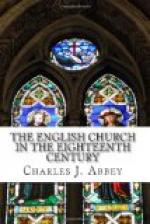Even at such times there were some who were proof
against the caprice of fashionable taste, and who
were not insensible to the solemn grandeur of ‘high
embowed roofs,’ ‘massy pillars,’
and ’storied windows.’[847] Lord Lyttelton
censured the old architecture as ’loaded with
a multiplicity of idle and useless parts,’ yet
granted that ’upon the whole it has a mighty
awful air, and strikes you with reverence.’[848]
Henry VII.’s Chapel at Westminster was still
regarded with admiration as ’that wonder of
the world;’[849] and although people did not
quite know what to do with their cathedrals, and regarded
them rather as curiosities, alien to the times, and
heirlooms from a dead past, they did not cease to speak
of them with some pride. But popular taste—so
far as architectural taste can be spoken of as prevalent
in any definite form throughout the greater part of
the last century—was all in favour of a
‘Palladian’ or ‘Greek’ style.
It was a style scarcely adapted to our climate, and
unfavourable to the symbolism of Christian thought,
yet capable, in the hands of a master, of being very
grand and imposing. Under weaker treatment the
effect was grievous. There was neither manliness
nor solemnity in the usual run of churches built after
the similitude of ’Roman theatres and Grecian
fanes.’[850] Maypoles instead of columns, capitals
of no order, and pie-crust decorations—such,
exclaimed Seward,[851] were the too frequent adjuncts
of the newly built churches he saw about him.
At the time, however, that Seward wrote, a change had
already begun to show itself in many influential quarters.
Even the ‘correct classicality’ of Sir
William Chambers,[852] the leading architect of the
day, met, towards the close of the century, with by
no means the same unquestioning admiration which he
had received at an earlier date. There was division
of opinion on fundamental questions of architectural
fitness; and persons could applaud the talents of mediaeval
builders without being considered eccentric. Gray,
Mason, Warton, Bishop Percy, and many others, had
contributed in various ways to create in England a
reaction, still more widely felt in Germany, in favour
of ideas which for some time past had been contemptuously
relegated to the darkness of the Middle Ages.
A frequent, though as yet not very discriminating,
approval of Gothic[853] architecture was part of the
movement. ‘High veneration,’ remarked
Dr. Sayers, writing about the last year of the century,
’has lately been revived for the pointed style.’[854]
It was one among many other outward signs of a change
gradually coming over the public mind on matters concerned
with the observances of religion.




